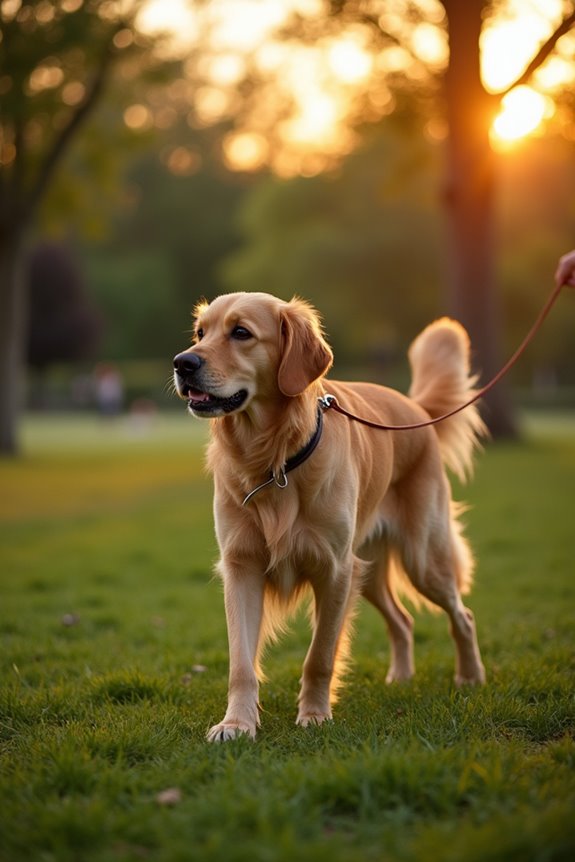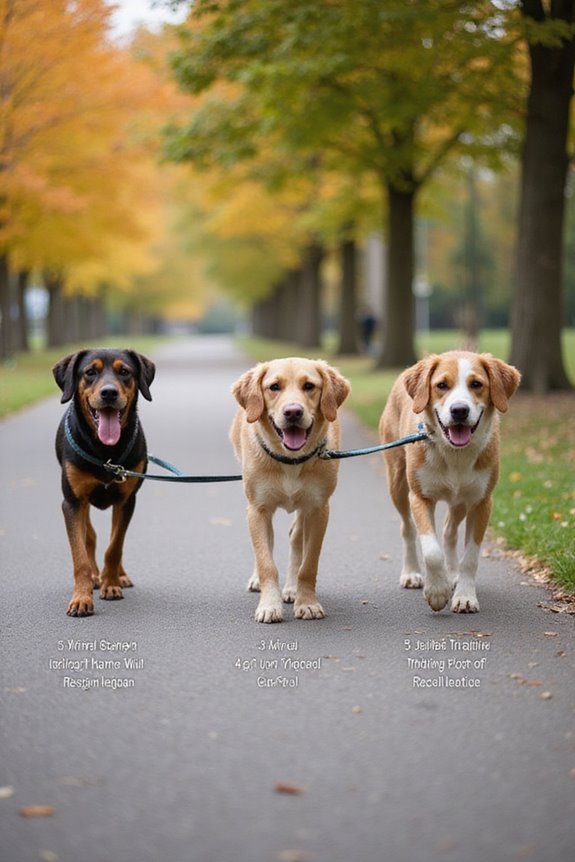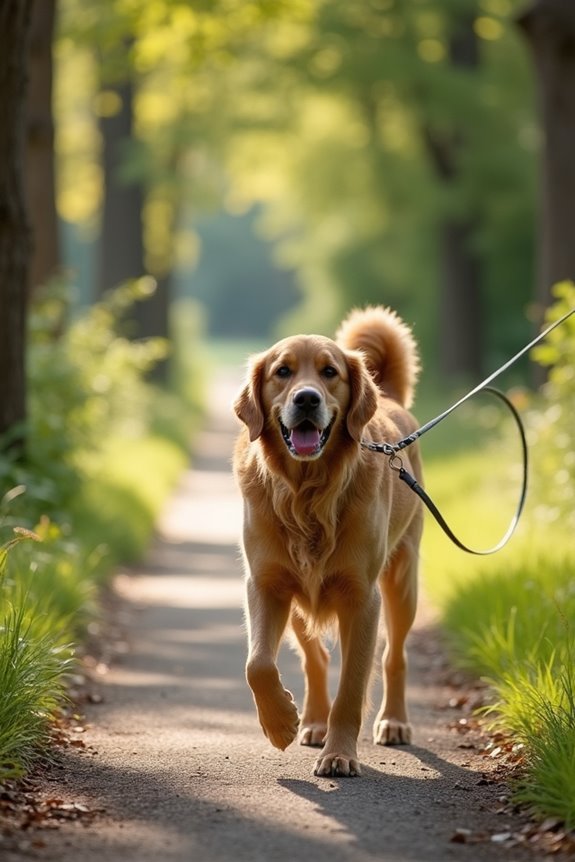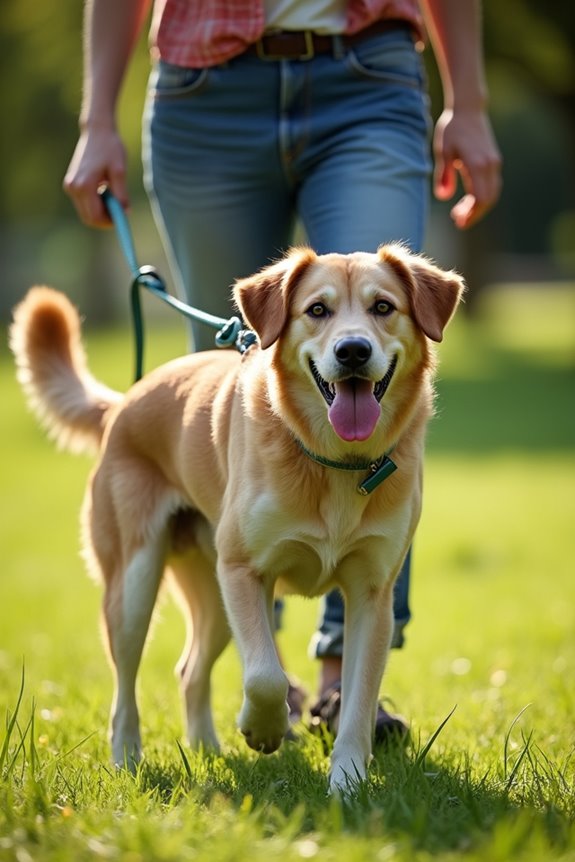When choosing a leash, I recommend considering your dog’s size, behavior, and training needs. For standard everyday walking, a 4 to 6-foot leash strikes a perfect balance between control and freedom. If you’re training a puppy, a 4-foot leash can provide extra guidance. For recall training or active play, long leashes ranging from 10 to 30 feet allow for exploration while still maintaining control. Understanding these options will help in selecting the best leash for your dog’s needs.
Key Takeaways
- Standard leash lengths for everyday walking are typically recommended at 4 to 6 feet for safety and control.
- For puppies needing guidance, a 4-foot leash is ideal to foster good behavior.
- Short leashes of 3 to 4 feet are effective in high-distraction environments for close control.
- Long leashes of 10 to 15 meters are suitable for recall training and controlled freedom.
- Always consider your dog’s size and strength when selecting the appropriate leash length.
Recommended Leash Lengths for Control and Training
When considering recommended leash lengths for control and training, it is essential to understand the balance between freedom and restraint that each length provides. Typically, a standard leash measures between 4 to 6 feet, which I find effective for walks and basic training.
- 4-foot leashes: Best for puppies or dogs needing extra guidance.
- Shorter leashes (3 feet): Suitable for initial training or high-distraction environments.
It’s important to think about leash materials too; durable, lightweight materials often provide the best comfort. As for leash colors, I prefer bright shades to enhance visibility.
Long Leashes and Long Lines for Freedom

Long leashes and long lines serve as invaluable tools for promoting freedom while maintaining the control necessary for responsible dog ownership. They facilitate freedom exploration, allowing our dogs to engage with their environment more thoroughly. By using a long line, we can enhance our dog’s confidence through gradual exposure to new stimuli, all while managing their safety.
- Start with a length of about 5 meters to guarantee comfort and control.
- Once established, you may increase to 10–15 meters for expanded freedom.
- Always consider your dog’s size and strength when selecting a leash.
Effective leash management minimizes the potential risks associated with extended lengths, promoting a calmer walking experience for both dog and handler.
Standard Leash Lengths and Typical Uses

In exploring leash options, it’s important to understand standard leash lengths and their typical uses. I’ve found that short leashes, typically 3 to 4 feet, are ideal for training puppies or maintaining close control in busy scenarios. For everyday walking, a 6-foot leash strikes the right balance between freedom and control, allowing for more comfortable obedience training with dogs that have had some experience.
Here’s a quick overview:
- 3 to 4-foot Leashes: Great for close control and crowded areas.
- 5 to 6-foot Leashes: Appropriate for general walking, providing enough length for relaxed movement without excess slack.
Choosing the right leash style and length can greatly enhance both your control and your dog’s safety during walks and training techniques.
Leash Length Recommendations by Activity

Selecting the right leash length for specific activities can greatly enhance both your and your dog’s experience.
Leash Length Recommendations
- Recall Training: Use 10 to 30-foot long lines to allow dogs to explore while maintaining control during training.
- Everyday Walking: A 4 to 6-foot leash is standard, providing safety and allowing natural exploration.
- Hiking: Opt for 10 to 30-foot leashes, ensuring dogs can experience trails while remaining tethered.
- Running: Choose leashes between 7 to 12 feet; adjustable options are ideal for maintaining control and rhythm.
Material Choices
When selecting leashes, consider durability, especially for hiking or running activities. Leash length variations cater to different environments, ensuring safety and freedom for your dog.
Leash Width and Strength Considerations

Choosing the appropriate width for a dog leash is essential for both safety and control, especially when considering a dog’s size and strength. The right leash width can greatly enhance your comfort as a handler.
- Under 30 lbs: 3/8 inch, lightweight yet strong.
- 30 to 60 lbs: 1/2 inch, allowing for balance between comfort and control.
- Over 60 lbs: At least 3/4 inch, ensuring durability against powerful pulls.
Leash materials also matter; nylon offers general durability, while BioThane provides high tensile strength, perfect for robust dogs. Leather requires thicker designs for heavy-duty use. Remember, wider leashes distribute pulling force better, reducing breakage risks and improving handling for strong pullers. Always match your leash choice to your dog’s size and behavior for the best experience.
Understanding Short Leashes for High Control
When considering the use of short leashes for high control, understanding their purpose and benefits is essential for ensuring effective handling of your dog. Short leashes, typically between 4 and 6 feet long, offer several advantages, particularly in urban walking situations:
- Direct Handling: They allow for close proximity, making it easier to correct behavior promptly.
- Minimized Distractions: Keeping your dog close minimizes distractions and fosters better focus on commands.
- Enhanced Safety: These leashes help avoid potential dangers, like traffic or unexpected encounters.
- Training Benefits: Ideal for teaching commands like “heel,” they promote clear communication.
In crowded environments, short leashes are indispensable for maintaining control and ensuring a calm, safe walking experience for both you and your dog.
Exploring the Versatility of Standard Leashes
Standard leashes, often recognized for their practicality, strike a remarkable balance between freedom and control, making them a popular choice among dog owners. Measuring between 4 to 6 feet long, these leashes are ideal for various activities. Here’s a closer look at their versatility:
- Everyday Use: Perfect for leisure strolls or trips to the park.
- Urban Safety: Crucial in busy areas, keeping your dog close amid foot traffic.
- Training Applications: Effective for commands like “sit” and “stay.”
- Vet Visits: Guarantees your dog’s safety during appointments.
- Diverse Leash Styles: Suitable for various dog sizes and temperaments.
Ultimately, standard leashes provide the necessary guidance while maintaining comfort in multiple situations, which is essential for responsible pet ownership.
Benefits of Long Leashes for Well-Behaved Dogs
Long leashes offer distinct advantages for well-behaved dogs, especially during training and outdoor activities. Here are some key long leash benefits worth considering:
- Enhanced Recall Training: Long leashes allow for practicing recall commands at greater distances, teaching dogs to respond even amidst distractions. Gentle tugs reinforce this without risk of escape.
- Controlled Freedom: With long leashes, dogs can explore safely, boosting their mental stimulation and well-being by reducing stress and allowing natural behaviors.
- Safe Socialization: They provide shy or anxious dogs an opportunity to observe and adjust to new environments, fostering confidence.
- Safety and Hazard Prevention: Long leashes help maintain control during outdoor excursions, effectively preventing potential hazards.
Selecting the Right Leash for Your Dog’s Needs
Selecting the correct leash for your dog is vital, as it greatly affects your pet’s safety and training effectiveness. It’s important to take into account factors like breed and size, as larger dogs may require more control. For training, a shorter leash (3-4 feet) is recommended to manage dog behavior effectively.
When choosing leash materials, nylon leashes are durable and adjustable, making them ideal for training purposes.
If you have a dog prone to pulling, a bungee leash can provide flexibility and shock absorption.
In crowded areas, a traffic leash (1 foot) guarantees minimal slack for better control.
Ultimately, the right leash enhances safety and helps your dog become more well-behaved and responsive. Choose wisely.
Frequently Asked Questions
How Do I Train My Dog to Walk on a Leash?
Training my dog to walk on a leash has been a rewarding experience. I focus on positive reinforcement, rewarding good behavior with treats and praise, ensuring we both enjoy our walks together and strengthen our bond.
Can I Use a Long Leash for Training Small Dogs?
Using a long leash for small dog training has its benefits, like fostering independence and recall. I’ve watched my pup thrive with that freedom, directly building trust and connection while we explore together. It’s magical!
What Leash Length Is Best for Large Dog Breeds?
When considering large dog breeds, I always prioritize leash safety. I find a 6-foot leash strikes that perfect balance, giving us control while allowing my pup enough freedom to explore during our walks together.
Do Certain Breeds Require Specific Leash Types?
I’ve found certain breeds really do require specific leashes. For instance, using a harness vs leash for larger, more powerful dogs enhances control. Breed-specific leashes can greatly improve safety and overall walking experience.
How Often Should I Replace My Dog’s Leash?
I’ve found that inspecting leash materials and safety features is essential. Typically, I replace my dog’s leash every 6–12 months, especially if I notice signs of wear or damage. Better safe than sorry, right?

